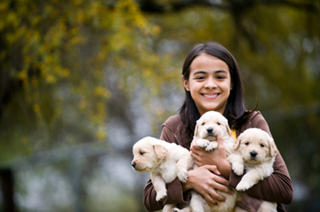Low Stress HousetrainingMike Romberger, CBCC-KA
Housetraining has nothing to do with teaching your dog to avoid using an area under a roof as a bathroom. It may eventually happen, but that is not how dogs see it. Dogs are naturally clean animals. They do not want to sleep, eat, or generally hang out in areas where they urinate or defecate. It is all about teaching a dog the most appropriate places to go potty. Even if an adult dog you brought home was housetrained in his foster home, you will still need to show him the new potty areas. You will find this document useful if you are bringing home a puppy, an adult dog, or have a dog that has lapses in housetraining. One of the tools I always recommend for is a dog crate. For more information on crates, see my companion article, “Crate Training Your Best Friend.” Housetraining and crate training go hand-in-hand. The crate uses your dog’s natural cleanliness to support housetraining. A properly sized crate should be about the same length as your dog with just enough room to turn around and lie down. A crate is too large if your dog can go potty in one corner and comfortably lie elsewhere in the crate. Once you have the crate in place, you can begin housetraining. The three keys to Low Stress Housetraining are routine, routine, and routine. By having a consistent plan paired with patience, your dog will soon learn that outside is the only place to go potty. Start your routine by picking the “potty area.” It should be a convenient spot and preferably has some lighting at night. Take your dog outside to the potty area on an hourly basis. Stop there and do not move around. Simply say “go potty” to the dog and wait. Since you do not want potty time to be confused with playtime, ignore your dog’s attempts to engage you in play. If your dog urinates or defecates, say “Good” and give the dog a treat. After the dog finishes, you can then play with or walk the dog as a reward. This simple routine reinforces going potty outside. The more frequently this is done, the easier it will be for the dog to want to go outside for a potty break. If your dog does not go potty within 5-10 minutes, take the dog back inside. Keep a close eye on the dog or put the dog in the crate. At this point, it is crucial that the dog does not have an accident. Any time your dog has an opportunity to have an accident inside the home; it allows your dog believe that there are multiple potty areas. After about 15 minutes, take the dog outside and try again. It will not take long for you and your dog to develop a routine. There are certain times when your dog should have a potty break.
There are a couple exceptions for puppies. A puppy cannot be fully housetrained until around six months of age. This is when the puppy develops the proper musculature to be housetrained. While a crate is a great tool, it should never be overused. A puppy left in the crate too long is forced to go potty inside the crate. This can make housetraining more difficult since the puppy is encouraged to lie in his own filth. As a general rule of thumb, a puppy can remain in a crate one hour for every month in age plus one. A two-month-old puppy can remain in the crate for three hours, or a four month old for five hours. So set your alarm to wake yourself at night. You may need to hire a dog walker if you are unable to get away from work during the day. Your feeding schedule can assist in your housetraining efforts. It is wise to time feed rather than free feed your dog. Free feeding is allowing your dog access to food throughout the day. A timed feeding schedule allows you to create a routine. With this schedule, you will feed your dog 2-3 times a day for 10-15 minutes. Save any leftover food for the next meal. In short, if you know when the food is going in, you will know when it needs to come out! As was mentioned, you want to go to great lengths to avoid accidents inside. However, it may still happen. If an accident occurs, DO NOT punish the dog. The only thing it will teach your dog is to avoid having an accident in front of you. If your dog has an accident inside or in the crate, take the dog outside for a potty break. Then clean the mess thoroughly with an enzymatic cleaner to destroy the odor. While carpet and floor cleaners are great at removing stains, odors stay behind. Use this accident as a learning experience. Did your dog give any signals that it was time to go potty? Did you wait too long to take your dog outside? Was the stool soft or runny, indicating your dog may be sick? Low Stress Housetraining is all about understanding your dog’s needs and using his natural abilities to your advantage. Before long, you will begin noticing your dog’s signals to go potty. After you have a routine established and can read the dog’s signals, you will be well on your way to having a housetrained dog. ©2013 Who's Your Doggie. Mike Romberger is the owner of Who’s Your Doggie in Harrisburg, PA. Mike is a certified canine behavior consultant that specializes in rescue dogs. He has spent most of his career preparing dogs for adoption by modifying behavior through positive reinforcement methods. Mike can be found at www.WhosDoggie.com. |



